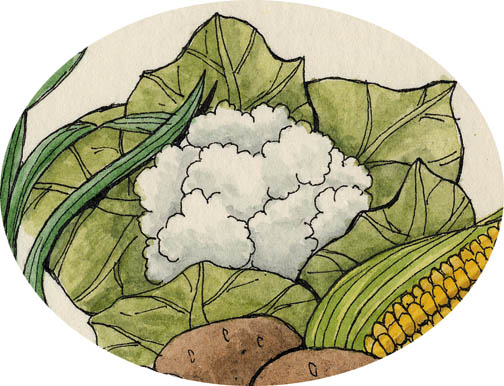

Starting Seeds: Plant cauliflower indoors in early spring. Harden off the seedlings by placing them outside in their pots for several days. Plant the hardened seedlings in the garden after the last frost. Cauliflower can be planted as seeds directly into the garden right after the last frost. Cauliflower seedlings are cold tolerant, but will die if struck by a hard frosted. Cauliflower does not do well in acid soils and prefer packed soil.
Planting in Garden: Plant seedlings (or seeds) 20 inches apart. Plant rows 24 inches apart. Deep beds can tolerate closer rows. For best results, dig planting hole, add a scoop of manure, pour in some water, set in your seedling, surround by soil and pat down. This provides everything a young seedling needs: nitrogen, water, soil gently packed around it. Mulch around the plants and between the rows to keep weeds down and keep the soil moist. When the cauliflower head develops, break some of the leaves over it and even tie them in place to protect the head from direct sun.
Harvest: Cut the large heads as soon as they are mature and before the head “loosens up” and begins to break down. To store them, pull them up by the roots and store in a cool, dark place, such as a root cellar.
Pests: Cabbage moths will lay their eggs on cauliflower. Watch for the small green caterpillars (larvae) and squish them! Turn over the leaves of your plants daily to search for caterpillars or watch for chewed leaves, find the caterpillars and squish them. They will blend it, so look carefully.
To avoid seedlings being damaged by cutworms, wrap small stems in about 2 inches of tin foil. The foil should extend an inch below the soil level and an inch above. This will stop cut works that clip plants right at below the soil’s surface.

